Inside Apple’s efforts to build a better recycling robot
Last week, TechCrunch paid a visit to Apple's Austin, Texas, manufacturing facilities. Since 2013, the company has built its Mac Pro desktop about 20 minutes north of downtown. The 400,000-square-foot facility sits in a maze of industry parks, a quick trip south from the company’s in-progress corporate campus. In recent years, the capital city has transformed into a hotbed of tech innovation, largely owing to a massive talent pool generated by nearby University of Texas at Austin.
Construction on a new $1 billion campus commenced in 2019. Shortly after the first phase was finished in 2022, the company announced plans for a further expansion scheduled to be completed in March 2025. All told, the Austin campus will comprise 133 acres — rivaling the size of its 175-acre Cupertino headquarters.
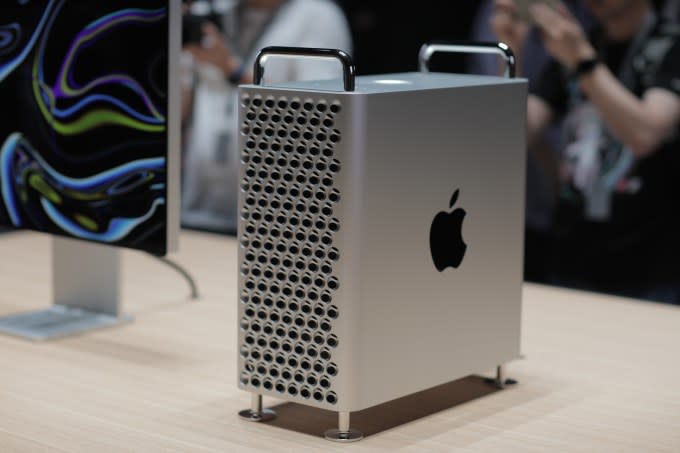
The Mac Pro presence, meanwhile, can be linked directly to the company’s bid to expand manufacturing in the U.S. The move brought around 900 jobs to the area, producing the infamous “trash can” version of Apple's most premium desktop. Just ahead of the pandemic, Apple confirmed that it would also be producing that model’s successor in the city.
After a quick security scan at the entrance, assembly lines populated with hundreds of the large “cheese grater” desktops greet visitors in the front of the facility. Beyond this sits row after row of floor-to-ceiling industrial shelving units housing nondescript cardboard boxes packed full of the pricey systems.
Chutes and litter
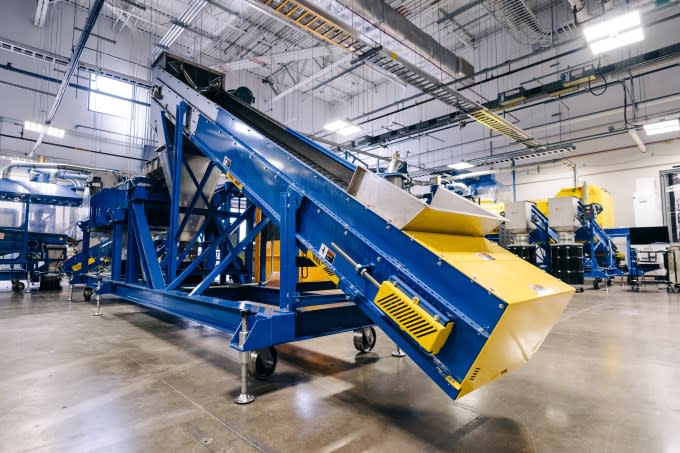
A small recycling facility lies just beyond that. The spot is home to a moderate-sized industrial e-waste sortation system. The maze of metal chutes utilizes high-powered magnets to extract metals and rare earth materials from Apple devices that have reached end of life. Most of the actual e-waste sortation occurs off-site in third-party e-waste management facilities. This specific system is instead utilized for the company’s ongoing push to improve the process.
Such projects are a key piece of Apple’s bid to make its supply chain process carbon neutral by 2030. The campaign follows a similar push to achieve carbon neutralization for its global corporate operations. Apple isn’t alone. Peers like Microsoft, Samsung and Google have announced similar goals to reduce their emissions.
Moving forward, robotics will take on an increasingly central role in these efforts. Startups like Amp Robotics and Glacier have emerged in recent years, bringing a combination of automation and AI-based vision systems to increase sortation efficacy and help close the loop on e-waste. It’s an admirable goal, to be sure, but technological efficacy and consumer participation still have a long way to go.
A very particular set of skills
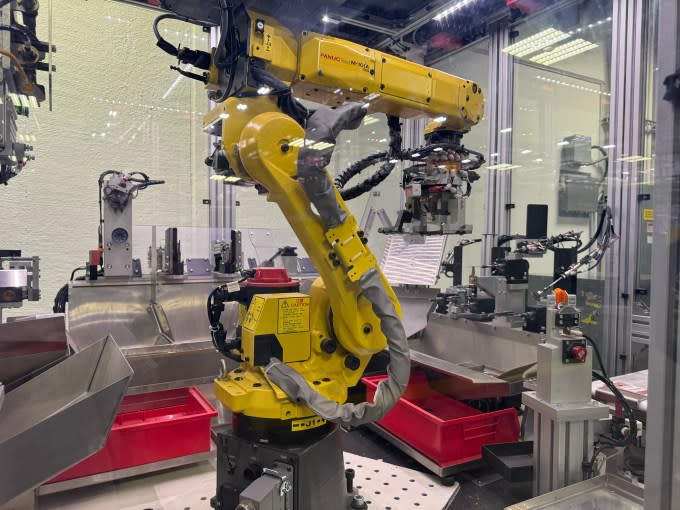
While Apple’s outward-facing robotics efforts have been relatively minimal compared to the likes of Amazon, automation has played some role in its device recycling efforts for more than a decade. Tim Cook kicked off a March 2016 iPad Pro keynote by breaking down the latest in the company’s sustainability efforts. Among the news was Liam, Apple’s latest attempt to leverage state-of-the-art robotics in its sortation efforts. The robot that debuted at that event was actually Liam 2.0, an update to a robot the company began piloting behind the scenes in 2013.
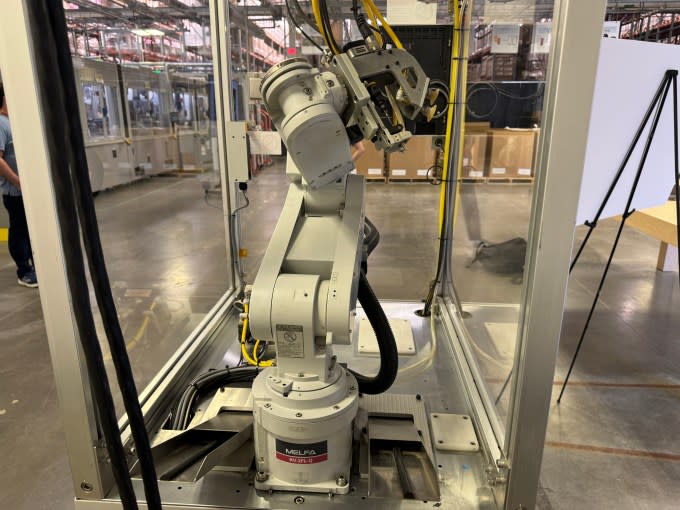
Liam 1.0 was very much a work in progress (a label that is easily applied to all of Apple robotics efforts to-date); in fact, the company now refers to the first-gen system as a “research project.” Utilizing a Fanuc industrial robotic arm, the caged system was designed to separate components on discarded iPhone 5s. Liam took 12 minutes to do its job.
A process clocking in at more than 10 minutes is of little value when contemplating the 133 million phones Americans discarded that year (11% of which were recycled). Any potential to put Liam 1.0 to work was further hampered by the fact that the system wasn’t remotely scalable.
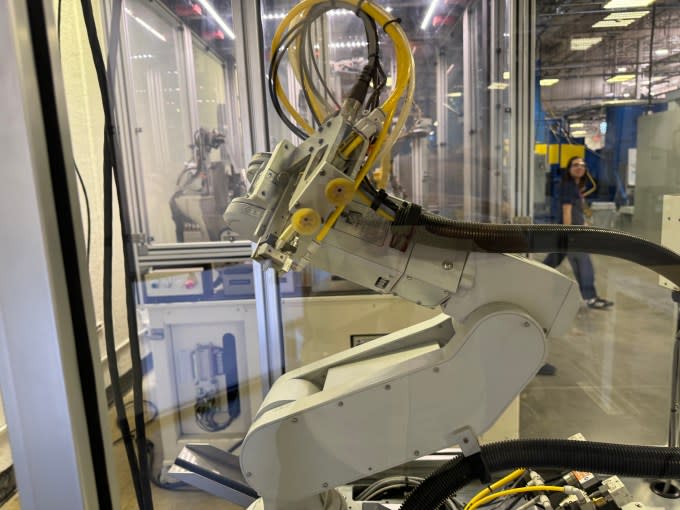
Liam 2.0 began operating behind the scenes in January 2015. The system delivered tangible improvements. Despite being smaller than its predecessor, the system dramatically reduced the process' time down to 11 seconds.
“The automated disassembly system was custom built for the iPhone 6 with the ability to disassemble 1.2 million iPhone units per year,” Apple noted in a 2016 whitepaper. “The output components from Liam are used for investigations in end-processing recycling technologies to recover materials that cannot be recovered at desired scale or purity today. Liam represents Apple’s investment in pre-processing technologies.”
While representing a significant improvement in efficacy, however, Liam 2.0 led a short life, resigning from its post in May 2016. It would take another six months before Apple filled the position.
A robot built for 1.2 million
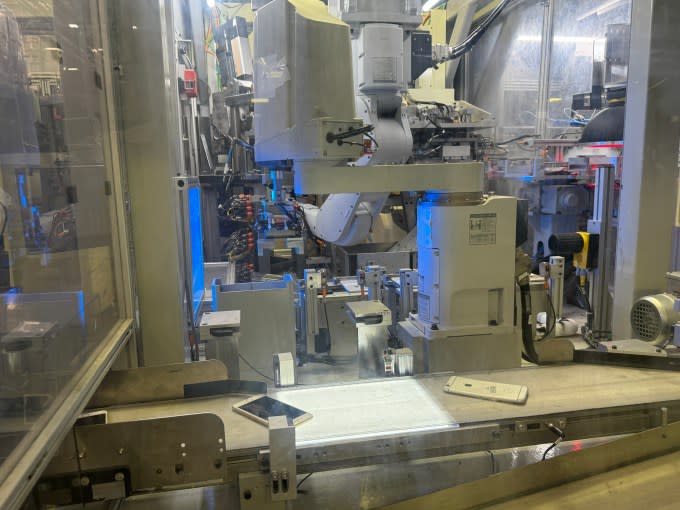
According to a spokesperson for the company, its robot names all begin as inside jokes. Sometimes — as in the case with Liam — they were initially created as very questionable acronyms.
“Basically, we’re all just environmental or robotics geeks,” Sarah Chandler, Vice President of Environment and Supply Chain Innovation, tells TechCrunch.
“Probably the one part of Apple where the geeks get to name it,” adds Patrick Wieler, Recycling Innovation Engineer. “Marketing hasn’t named them.”
In spite of the fact that Apple has subsequently deployed a system named “Dave” to extract the Taptic Engine from devices, it assures me that neither are a reference to Arthur C. Clarke’s robotic cautionary tale, "2001: A Space Odyssey."
The newest robot adds a bit more time to the process, which now clocks in at 18 seconds.
However, Daisy significantly reduces Liam’s overall footprint from 29 robots across 100 feet to four primary modules, while increasing the number of material output streams from 8 to 15. The biggest improvement is the increase in compatibility from a single iPhone model (the 6 in the case of Liam 2.0) to several. Apple has continually updated that figure in the 7.5 years since Daisy arrived. The robot now handles 29 different models, up from 18 a year and a half ago.
The stark difference in cycle times between Liam 1.0 and Daisy is due, in part, to a fundamental rethink of the separation process. Whereas the first robot gingerly unscrewed the various components, newer versions take a kind of brute force approach. The robots “punch out” the component now. Turns out it’s significantly faster to effectively rip a phone apart, and while the result is a lot less pretty, no one cares what discarded phones look like. It’s not being refurbished, after all; it’s being melted down.
Enter the four chambers
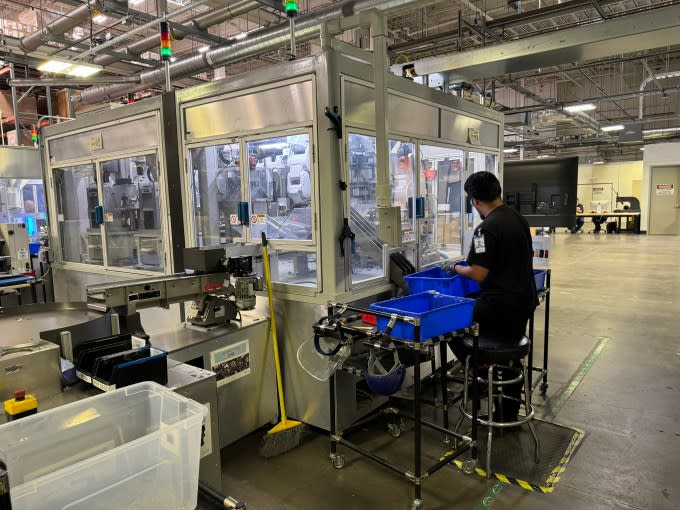
Daisy sits in a cordoned-off section of the floor, in front of two rows of tall cardboard boxes that are gradually filled with tiny, extracted components. The system is noisy when operational, a combination of metal punching metal and the hiss of hydraulics. Although it’s not loud enough to necessitate the wearing of ear protection, I certainly wouldn’t recommend attempting to conduct an interview nearby.
While significantly smaller than earlier robots, Daisy is still imposing, measuring 33 feet, end to end. Like many industrial robots, its components are housed inside a protective structure, helping to avoid any potential run-ins between a big, metal system and fragile human flesh. People are still in the loop, however, with three to four people managing different stations. The system is composed of four large glass boxes with industrial metal frames.
The process starts when a human enters a bucketful of iPhones into the chute, after which Daisy individually places them onto a conveyor belt, one at a time. From there, the onboard imaging system scans every device. If it detects that one has entered the system facedown, it goes back to the beginning. Rather than using a robotic system to right the device, each one cycles through this process until it lands face down, which, as you’d imagine, is a 50% probability.
If the device has entered the system with the correct orientation, a combination of imaging and machine learning identifies the model type, which Daisy then handles accordingly. Liam’s Fanuc arms have been replaced by Mitsubishi models. Like most industrial robotic arms, these were initially designed with automotive manufacturing in mind.
That industry is, after all, decades ahead of everyone else when it comes to deploying industrial automation. A first robot arm picks the phone up and places it onto a pad, where a second arm picks it up places it into a metal bracket before peeling the display off the device.
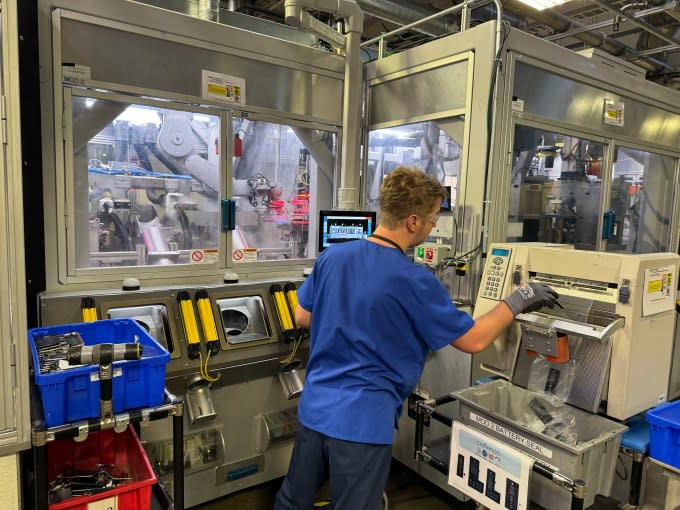
The second chamber is the most visual arresting of the four, owing to the visible fog streaming out from industrial cooling units kept at –80°C (–112°F). This is well below the 32°F to 95°F (0°C to 35°C) ambient temperature Apple recommends for the iPhone. In fact, it’s cold enough to make the battery adhesive fail. After exposing the device to the extreme cold, Daisy slams the battery out. A second person stands at this station, monitoring operations and retrieving the discarded batteries.
Inside the third chamber, Daisy goes to work knocking out the tiny screw, freeing the individual component. This is where the brute force really comes into play. Punching is significantly faster than using the robot to individually unscrew each piece. Once in the fourth and final chamber, a rotating tool scrapes on the individual components, where they land on a vibrating screen mesh, which helps separate the pieces out.
From there, they land on a large, spinning surface, where another human is tasked with separating the pieces into different component piles. Those will be emptied into the nearby cardboard boxes, which, once full, will ship to an e-waste rendering facility.
Getting a grip
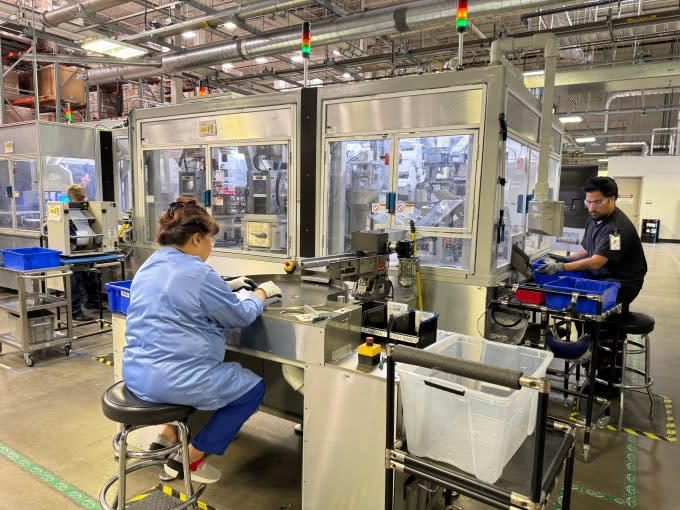
In fact, much like Liam, Daisy is composed of majority off-the-shelf components. This is standard in the word of robotics, where the prevailing approach to building systems is not reinventing the wheel for the sake of itself. This is especially the case with Daisy, of which two units have been produced. The minority of components built in house are the end effectors, which are designed specifically to accommodate iPhones.
An early version of Liam relied on a pneumatic suction cup system — an option that has found increasing favor in the industrial space in the last decade-plus. With Daisy, however, the company went back to a rigid gripper. While more stable than its soft robotics counterparts, these systems are not as compliant.
That’s a huge benefit when attempting to grip objects like produce, which can vary a good deal from one to the next. If your system is designed to pick up objects like iPhones, with finite dimensional variations, the benefits of a compliment gripper are less pronounced.
The Austin system handles North American devices, while its counterpart in Breda, Netherlands, manages Europe’s discarded iPhones. There is currently no equivalent system in Asia, Africa, South America or Oceania. Apple does, however, deploy a pair of systems — Dave and Taz — close to its manufacturing facilities in China. These systems are specially designed to extract haptic and audio components from the phone.
Scratching the surface
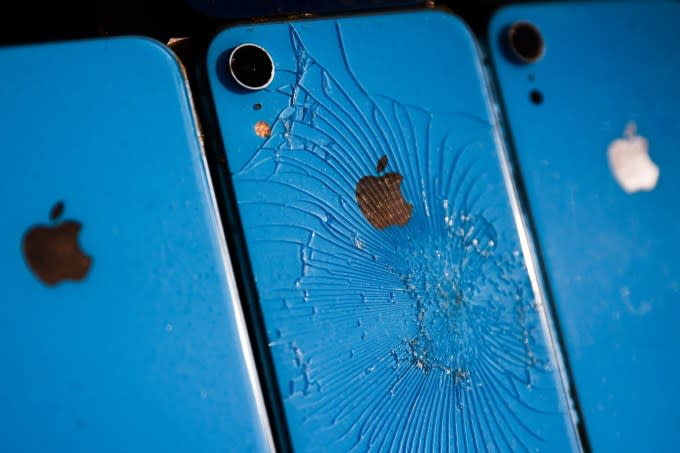
At its current pace, Daisy can strip up to 1.2 million iPhones a year. It’s a massive improvement over earlier models, but it’s ultimately a drop in the bucket, compared to the 150 million smartphones that were discarded in 2023 (roughly 416,000 per day). That in turn is a mere fraction of the 68 million tons of gadgets that were thrown out globally. Around 22% of that number was recycled, though, according to the UN, the rate at which electronics are discarded is "rising five times faster than documented recycling."
While a nice start, recycling robots like Daisy have substantial scaling to do if they’re going to have a meaningful impact on the $62 billion in natural resources that were thrown out instead of recycled last year.
Much of the issue stems from a lack of education or initiative around electronics recycling. Too many people keep old devices in drawers forever (guilty) or simply throw them out with the trash.
“Hopefully you’ve seen our reports,” says Chandler. “We’ve published websites and other lengthy reports.” I have, and if you’ve made it this far into the piece, there’s a decent chance you have, as well. Average iPhone buyers, on the other hand, aren’t sitting down to read Apple whitepapers in their limited free time.
Chandler adds, “We’re trying to play with messaging and get more resonance to find out what connects with people.”
Apple sees Daisy as a kind of ambassador for its recycling efforts. It not nearly where it needs to be in terms of speed and efficiency, but it’s something headline grabbing that puts more eyes on the company’s end-of-life efforts.
“One metric ton of material recovered from Daisy prevents 2,000 metric tons of mining,” Chandler says. “I think we need to continue to do more and more with customer engagement. That’s why this isn’t going to be Daisy’s most productive day. She’s running a little slower to accommodate [our facility tour]. But that’s worth it. That’s how we get the message out.”
In addition to improving Daisy’s throughput and — potentially — building more robots in new and existing geographies, true proficiency means creating systems that manage an even greater product portfolio. Apple believes it’s possible to adapt these systems to manage non-iPhone products like MacBooks and iPads, but the company won’t reveal what’s coming down the pipeline.
Apple has also invited other companies to license its Daisy IP patents for free. While there’s a good bit of variation between devices and manufacturing processes, many of the steps are adaptable to other smartphones. While it’s had conversations with some of the competition, no one has yet to take Apple up on the offer.
Extended life
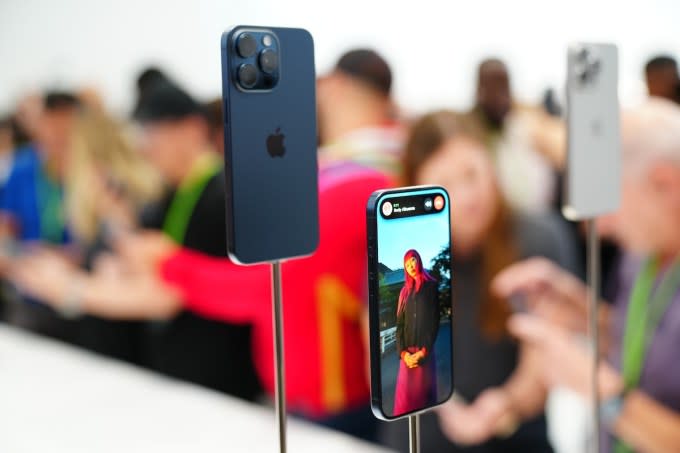
When Daisy started operation in November 2016, Apple anticipated that the industrial robotic system would be operational for two to three years. After all, the two Liams that preceded it only hung around for a year or two. Apple briefly brought the robotic arm portion of both systems out for retirement as a kind of museum piece to demonstrate how far the technology has come in the past decade.
Daisy is still chugging along 7.5 years later. Apple attributes such longevity to the system’s adaptability, as tweaks to software and hardware have continued to grow the number of iPhones the robot can handle.
Some of those improvements arrived by way of partnerships with schools like Carnegie Mellon University, a leading institution for robotics research and one of the birthplaces of autonomous driving. That specific partnership began around 2019.
There’s also a good deal of shared learning across Apple’s different divisions.
“It’s a constant dialogue,” says Wieler. “We learn a ton from the automation team working on the new products, because they’re always faced with their own unique set of challenges. We can build on their learning there and then vice versa with their teams. When we share how we were programming Daisy, it allows them to think about new approaches to the automation of new products.”
Apple robotics

The recent dissolution of Apple’s ill-fated electric car project reportedly spurred the company to explore the notoriously difficult world of home robots. Prior to 2022, the company was said to be exploring autonomous capabilities, but ultimately dropped the plan as it scaled back work on the so-called Project Titan.
Before it was abandoned, the company built an impressive team with expertise in fields like computer vision, machine learning and automation that are key to robots like Daisy. Apple declined to go into details around the impact those projects might have had on Daisy’s development.
Austin was a logical place for Daisy, given the amount of money the company has invested in the area. The city also gives Apple access to the growing powerhouse that is University of Texas at Austin’s robotics department.
“We’ve got strong, long-standing connections here. We’ve obviously got a lot of big campuses here, so we’re able to do a bunch of recycling here,” says Chandler. And it’s been great for academic partnerships, too. We are able to get quite a few interns. We get a lot folks who want to explore robotics, recycling and material recovery.”
Like all major corporations, robotics’ role will only grow at Apple in the future. That includes manufacturing, testing, recycling and, perhaps one day, commercially available products.
“It’s so important to do it internally,” says Wieler. “Every evolution taught what we can do with automation and gives us a big step forward.”
Chandler adds, “We need to make [Daisy] as obsolete as [Liam]. You’ve always got to keep pushing further.”
Update: The story has been updated to reflect that the new time for Daisy's process is 18 seconds.

